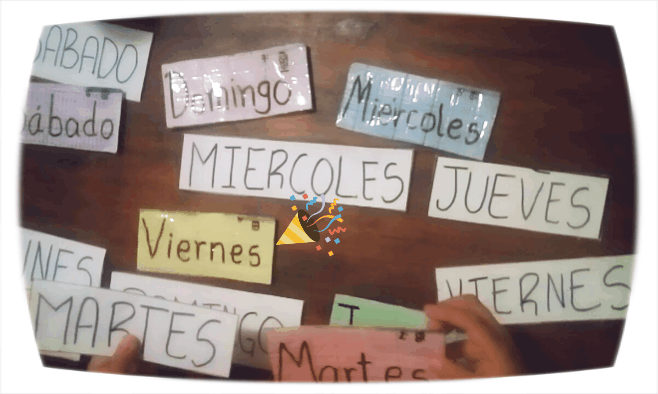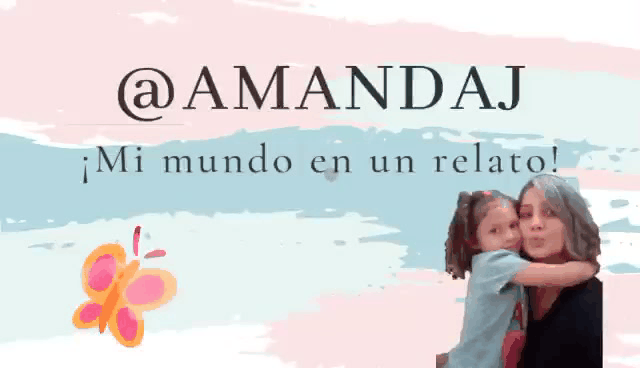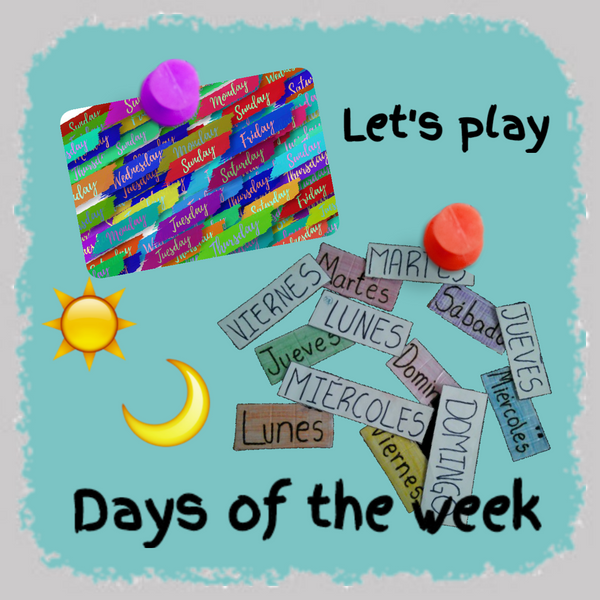Aprender en el hogar tienes sus ventajas porque de un interés en la intimidad que el niño exponga en una pregunta termina en una actividad didáctica. Así surgió la siguiente estrategia para enseñar a mi niña Amanda los días de la semana, a partir de la pregunta "qué día es hoy", me inspiré en crear actividades para el reconocimiento escrito y verbal de los días de la semana.
Los niños desarrollan la noción temporal durante las experiencias que viven. Amanda está en la etapa donde se confunde, puede referirse a mañana como hoy o ayer y viceversa, debido a que es un concepto abstracto; por esa razón surge la necesidad de preguntar "qué dia es hoy y cuántos días falta para.. ", pero en esta oportunidad les explicaré cómo orienté el proceso de reconocer los nombres de la semana por escrito. Cabe destacar que para llegar a ello, con anterioridad mi niña aprendió el concepto de orden, pasos, secuencias, día, tarde, noche, velocidad y los días a través de otras prácticas educativas en el hogar, lo cual facilita apropiarse de los días de la semana.
Learning at home has its advantages because of an interest in intimacy that the child exposes in a question ends with a didactic activity. This is how the following strategy emerged to teach my daughter Amanda the days of the week, from the question "what day is today", I was inspired to create activities for the written and verbal recognition of the days of the week.
Children develop the notion of time during the experiences they live. Amanda is at the stage where she gets confused, she can refer to tomorrow as today or yesterday and vice versa, because it is an abstract concept; for that reason the need to ask "what day is today and how many days until..." arises, but in this opportunity I will explain how I guided the process of recognizing the names of the week in writing. But this time I will explain how I oriented the process of recognizing the names of the week in writing. It should be noted that in order to achieve this, my child previously learned the concept of order, steps, sequences, day, afternoon, evening, night, speed and days through other educational practices at home, which facilitates the appropriation of the days of the week.

Amanda tiene 4 años y 11 meses, está curiosa por aprender los días de la semana, quiere leer y escribir, usa los signos para representar ideas que tenga significado para ella. De igual manera, aprendió escribir su nombre, el nombre de la maestra, de su mejor amiga, también mamá y papá. Según el ritmo, conocimiento, atención e interés de mi hija uso estrategias didácticas, las cuales complejizo para que asimile, comprenda y ponga en práctica lo internalizado en este caso los días de la semana.
Amanda is 4 years and 11 months old, she is curious to learn the days of the week, she wants to read and write, she uses signs to represent ideas that have meaning to her. She has also learned to write her name, her teacher's name, her best friend's name, as well as mommy and daddy. According to the rhythm, knowledge, attention and interest of my daughter, I use didactic strategies, which I make more complex, so that she assimilates, understands and puts into practice what she has internalized, in this case the days of the week.

Reconocimiento escrito de los días de la semana. La actividad se la estructuré de la siguiente manera y sus diferentes variantes: escribir en tiras de hojas o cartulinas de distintos colores o pueden usar material reciclable los días de la semana. Cada día está asociado a un número y dibujo. Esto permite relacionar el color, el orden y la sílaba con el dibujo que empieza la semana, además de identificar la letra que inicia el nombre del día.
Written recognition of the days of the week. The activity was structured in the following way and its different variants: write the days of the week on strips of paper or cardboard of different colors or use recyclable material. Each day is associated with a number and a drawing. This allows them to relate the color, order and syllable with the drawing that begins the week, in addition to identifying the letter that begins the name of the day.
Recuerden que la práctica hace que se fije en la memoria; una variante es practicar de forma aleatoria, así refuerzar los nombres. Después tachar los días y las siluetas de los dibujos. Amanda en esta etapa reconoce los días de la semana sin los dibujos y números porque aún está el color en cada nombre. A veces jugamos con los peluches imitando que son estudiantes para aprender, simulo equivocarme para que ella me corrigiera sobre los días.
Remember that practice makes memory stick; a variation is to practice randomly, thus reinforcing the names. Then cross out the days and the silhouettes of the drawings. Amanda at this stage recognizes the days of the week without the pictures and numbers because there is still the color in each name. Sometimes we play with the stuffed animals pretending they are students to learn, I pretend to make a mistake so she corrects me on the days.

Otra variante, sería escribir todos los días de la semana en tiras de hojas blancas, con letras en mayúsculas y en negro. Jugamos a emparejar con las de colores para luego identificarlas sin ver las tiras de referencias a color. Asimismo enseñar de manera aleatoria y ordenar según la secuencia de los días.
Another variant would be to write all the days of the week on strips of white paper, with capital letters in black. We play in matching with the colored ones and then identify them without seeing the colored reference strips. Also teach randomly and order according to the sequence of the days.
Posteriormente escribo en una hoja los días de la semana y le indico visualmente o verbal buscar un día determinado y lo ubica. Amanda avanza rápido, logros que se dan en pequeñas sesiones divertidas. También repasar las letras que constituyen el día y podemos indicar cuántas tiene. Por otra parte, quiso escribir los días de la semana en una hoja y que mamá ubicará el día que ella indicara, me tomé mi tiempo para que me ayudara.
I then write on a sheet of paper the days of the week and visually or verbally indicate to her to look for a certain day and she locates it. Amanda progresses quickly, accomplishments that happen in small fun sessions. We also review the letters that make up the day and we can indicate how many letters she has. On the other hand, she wanted to write the days of the week on a sheet of paper and have mommy locate the day she indicated, I took my time to get her to help me.


El proceso de aprender debe ser placentero, empezar desde el interés y luego crear juntos con los niños. Amanda está desarrollando los procesos cognitivos memoria, observación, reconocimiento, clasificación, asociación, lógica y solución de problema. Está iniciando en el proceso de lectoescritura, usa su dedo para leer, aunque no identifique todo la palabra, tiene un acercamiento agradable con la escritura y lectura. Amanda generaliza y transfiere palabras a otros contextos diferentes y similares; no obstante, la noción temporal de los días de la semana los reconoce, en este caso no hay generalización y fue el deseo particular de Amanda por aprender.
The process of learning should be enjoyable, start from interest and then create together with the children. Amanda is developing the cognitive processes of memory, observation, recognition, classification, association, logic and problem solving. She is beginning the process of reading and writing, she uses her finger to read, although she does not identify all the words, she has a pleasant approach to writing and reading. Amanda generalizes and transfers words to other different and similar contexts; however, she recognizes the temporal notion of the days of the week, in this case there is no generalization and it was Amanda's particular desire to learn.
La próxima actividad está orientada acerca de la noción temporal hoy es, ayer fue y mañana será.
The next activity is oriented to the notion of time: today is, yesterday was and tomorrow will be.

Publicación inspirada en mi experiencia profesional como educadora y formadora de estudiantes en educación integral

Agradezco la visita y el apoyo a mi producción
 Primera imagen y otras creadas con la aplicación Fotocollages. Fotos tomadas con mi teléfono móvil noblex modelo 551. Gif elaborado con la aplicación creador y editor de gif
Primera imagen y otras creadas con la aplicación Fotocollages. Fotos tomadas con mi teléfono móvil noblex modelo 551. Gif elaborado con la aplicación creador y editor de gif


Soy miembro de @motherhood

 Diseño realizado en Canva
Diseño realizado en Canva
@AntonietaGonzl7 Twitter

Las publicaciones elaboradas en mi blog son realizadas desde un móvil Noblex modelo 551.


















This is educational and applicable especially for young learners who are in the stage of learning days of the week. Since our country (Philippines) was influenced by some Spanish words then we don't have differences in the sounding of the words though it spelled differently. I am wishing you to continue posting learning content like this because it's helpful for the children to increase their vocabulary. Well done
Hello, @missdonna
Happy for the recognition of my publication. I am sure I will be creating more educational activities. Your visit motivates me to continue structuring more strategies.
Thank you
Good day, and first of all, I would like to say that we also use those names of days (with a bit of difference in spelling). With that being said, I will re-create (using our local language) this one for my son so that he will be familiarized with the names of the days.
Hello,@afterglow
Compassion for considering this proposal for implementation with your child. Take time for your child to become familiar with, understand, repeat or change the activity or explanation, we are all different, you know your child.
Thank you for your support
Thank you for that heartfelt advice and you're welcome also (^_^)
The rewards earned on this comment will go directly to the person sharing the post on Twitter as long as they are registered with @poshtoken. Sign up at https://hiveposh.com.
@tipu curate
Upvoted 👌 (Mana: 13/93) Liquid rewards.